Detailed Report on Auditing and Assurance Standards for Morris Ltd
VerifiedAdded on 2022/08/23
|12
|1998
|19
Report
AI Summary
This report delves into the auditing and assurance standards applicable to Morris Ltd, a company recently listed on the Australian Securities Exchange. The analysis begins with an examination of risk assessment procedures, emphasizing the role of analytical procedures in identifying material misstatements. It then explores the importance of professional skepticism in auditing, highlighting its significance in evaluating management's information and detecting potential errors. The report further addresses the concept of materiality, outlining its application in audit planning and performance, and providing calculations based on financial data. Ratio analysis is performed to evaluate the company's profitability, liquidity, and solvency, comparing key financial metrics over two years. Finally, the report assesses Morris Ltd's going concern status, identifying potential risks based on financial ratios and other factors, such as declining current ratios, negative profit margins, and high debt levels. The report also highlights the potential impact of external factors, such as tropical cyclones on the company's operations, providing a comprehensive overview of the audit considerations.
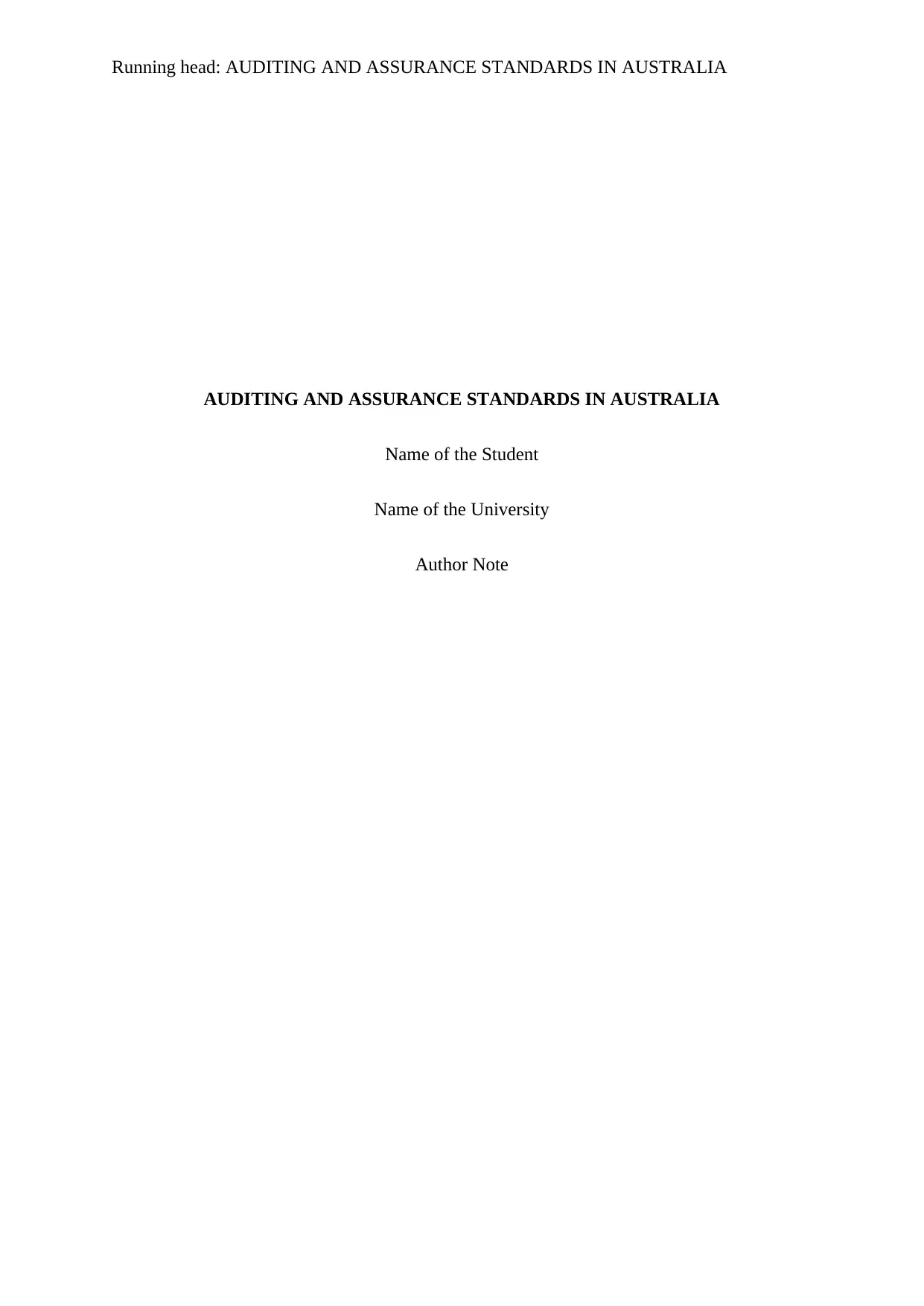
Running head: AUDITING AND ASSURANCE STANDARDS IN AUSTRALIA
AUDITING AND ASSURANCE STANDARDS IN AUSTRALIA
Name of the Student
Name of the University
Author Note
AUDITING AND ASSURANCE STANDARDS IN AUSTRALIA
Name of the Student
Name of the University
Author Note
Paraphrase This Document
Need a fresh take? Get an instant paraphrase of this document with our AI Paraphraser
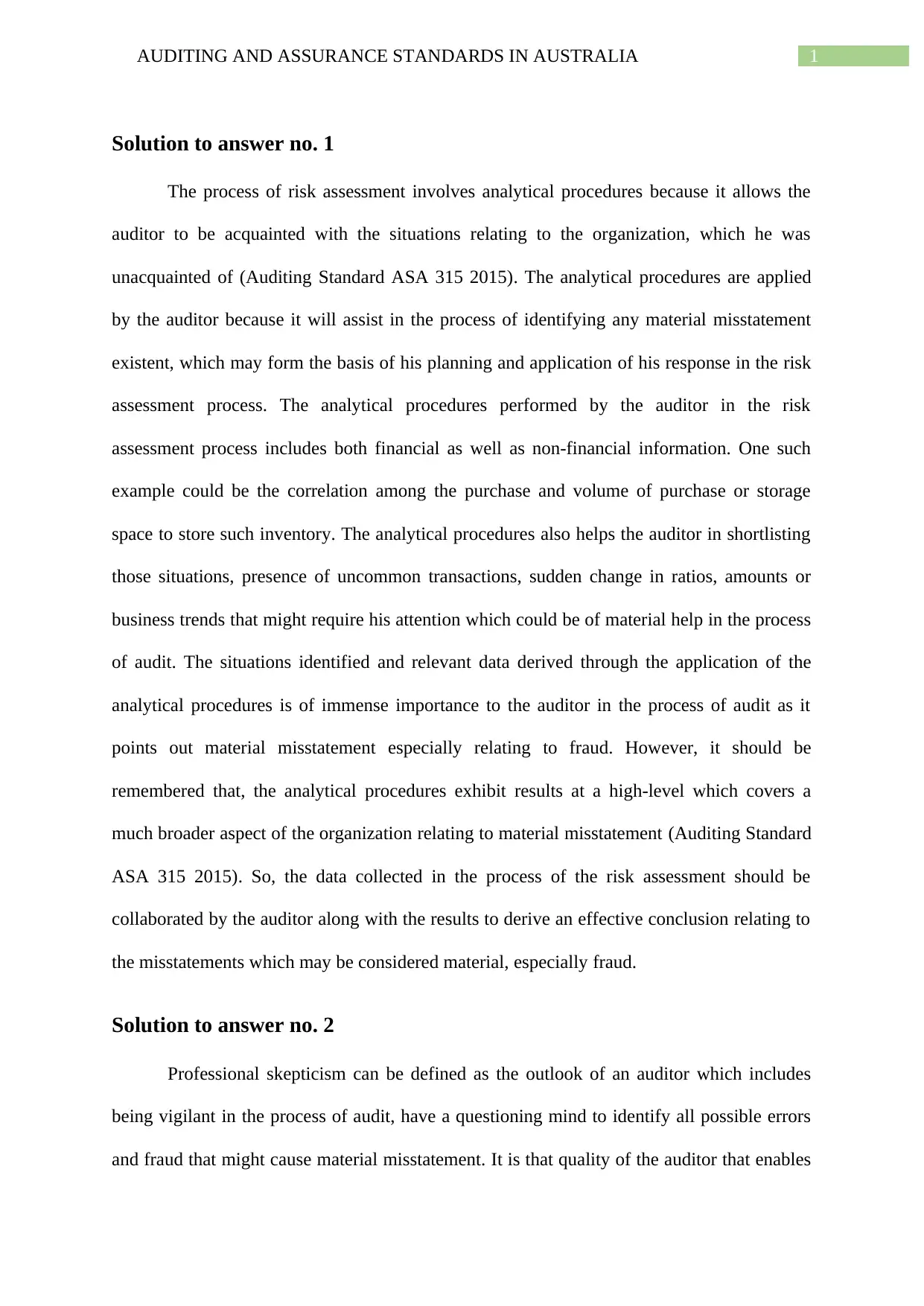
1AUDITING AND ASSURANCE STANDARDS IN AUSTRALIA
Solution to answer no. 1
The process of risk assessment involves analytical procedures because it allows the
auditor to be acquainted with the situations relating to the organization, which he was
unacquainted of (Auditing Standard ASA 315 2015). The analytical procedures are applied
by the auditor because it will assist in the process of identifying any material misstatement
existent, which may form the basis of his planning and application of his response in the risk
assessment process. The analytical procedures performed by the auditor in the risk
assessment process includes both financial as well as non-financial information. One such
example could be the correlation among the purchase and volume of purchase or storage
space to store such inventory. The analytical procedures also helps the auditor in shortlisting
those situations, presence of uncommon transactions, sudden change in ratios, amounts or
business trends that might require his attention which could be of material help in the process
of audit. The situations identified and relevant data derived through the application of the
analytical procedures is of immense importance to the auditor in the process of audit as it
points out material misstatement especially relating to fraud. However, it should be
remembered that, the analytical procedures exhibit results at a high-level which covers a
much broader aspect of the organization relating to material misstatement (Auditing Standard
ASA 315 2015). So, the data collected in the process of the risk assessment should be
collaborated by the auditor along with the results to derive an effective conclusion relating to
the misstatements which may be considered material, especially fraud.
Solution to answer no. 2
Professional skepticism can be defined as the outlook of an auditor which includes
being vigilant in the process of audit, have a questioning mind to identify all possible errors
and fraud that might cause material misstatement. It is that quality of the auditor that enables
Solution to answer no. 1
The process of risk assessment involves analytical procedures because it allows the
auditor to be acquainted with the situations relating to the organization, which he was
unacquainted of (Auditing Standard ASA 315 2015). The analytical procedures are applied
by the auditor because it will assist in the process of identifying any material misstatement
existent, which may form the basis of his planning and application of his response in the risk
assessment process. The analytical procedures performed by the auditor in the risk
assessment process includes both financial as well as non-financial information. One such
example could be the correlation among the purchase and volume of purchase or storage
space to store such inventory. The analytical procedures also helps the auditor in shortlisting
those situations, presence of uncommon transactions, sudden change in ratios, amounts or
business trends that might require his attention which could be of material help in the process
of audit. The situations identified and relevant data derived through the application of the
analytical procedures is of immense importance to the auditor in the process of audit as it
points out material misstatement especially relating to fraud. However, it should be
remembered that, the analytical procedures exhibit results at a high-level which covers a
much broader aspect of the organization relating to material misstatement (Auditing Standard
ASA 315 2015). So, the data collected in the process of the risk assessment should be
collaborated by the auditor along with the results to derive an effective conclusion relating to
the misstatements which may be considered material, especially fraud.
Solution to answer no. 2
Professional skepticism can be defined as the outlook of an auditor which includes
being vigilant in the process of audit, have a questioning mind to identify all possible errors
and fraud that might cause material misstatement. It is that quality of the auditor that enables
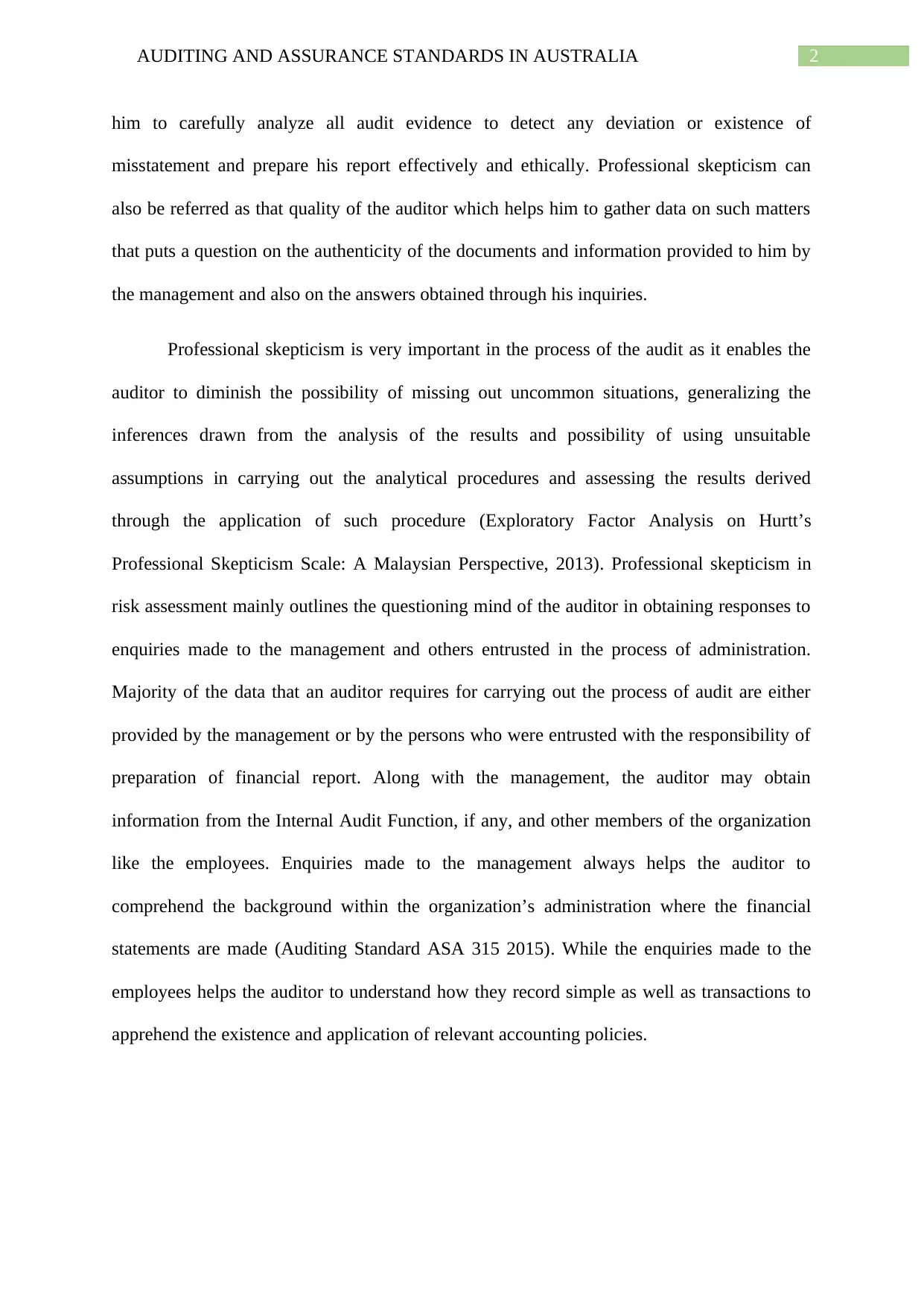
2AUDITING AND ASSURANCE STANDARDS IN AUSTRALIA
him to carefully analyze all audit evidence to detect any deviation or existence of
misstatement and prepare his report effectively and ethically. Professional skepticism can
also be referred as that quality of the auditor which helps him to gather data on such matters
that puts a question on the authenticity of the documents and information provided to him by
the management and also on the answers obtained through his inquiries.
Professional skepticism is very important in the process of the audit as it enables the
auditor to diminish the possibility of missing out uncommon situations, generalizing the
inferences drawn from the analysis of the results and possibility of using unsuitable
assumptions in carrying out the analytical procedures and assessing the results derived
through the application of such procedure (Exploratory Factor Analysis on Hurtt’s
Professional Skepticism Scale: A Malaysian Perspective, 2013). Professional skepticism in
risk assessment mainly outlines the questioning mind of the auditor in obtaining responses to
enquiries made to the management and others entrusted in the process of administration.
Majority of the data that an auditor requires for carrying out the process of audit are either
provided by the management or by the persons who were entrusted with the responsibility of
preparation of financial report. Along with the management, the auditor may obtain
information from the Internal Audit Function, if any, and other members of the organization
like the employees. Enquiries made to the management always helps the auditor to
comprehend the background within the organization’s administration where the financial
statements are made (Auditing Standard ASA 315 2015). While the enquiries made to the
employees helps the auditor to understand how they record simple as well as transactions to
apprehend the existence and application of relevant accounting policies.
him to carefully analyze all audit evidence to detect any deviation or existence of
misstatement and prepare his report effectively and ethically. Professional skepticism can
also be referred as that quality of the auditor which helps him to gather data on such matters
that puts a question on the authenticity of the documents and information provided to him by
the management and also on the answers obtained through his inquiries.
Professional skepticism is very important in the process of the audit as it enables the
auditor to diminish the possibility of missing out uncommon situations, generalizing the
inferences drawn from the analysis of the results and possibility of using unsuitable
assumptions in carrying out the analytical procedures and assessing the results derived
through the application of such procedure (Exploratory Factor Analysis on Hurtt’s
Professional Skepticism Scale: A Malaysian Perspective, 2013). Professional skepticism in
risk assessment mainly outlines the questioning mind of the auditor in obtaining responses to
enquiries made to the management and others entrusted in the process of administration.
Majority of the data that an auditor requires for carrying out the process of audit are either
provided by the management or by the persons who were entrusted with the responsibility of
preparation of financial report. Along with the management, the auditor may obtain
information from the Internal Audit Function, if any, and other members of the organization
like the employees. Enquiries made to the management always helps the auditor to
comprehend the background within the organization’s administration where the financial
statements are made (Auditing Standard ASA 315 2015). While the enquiries made to the
employees helps the auditor to understand how they record simple as well as transactions to
apprehend the existence and application of relevant accounting policies.
⊘ This is a preview!⊘
Do you want full access?
Subscribe today to unlock all pages.

Trusted by 1+ million students worldwide
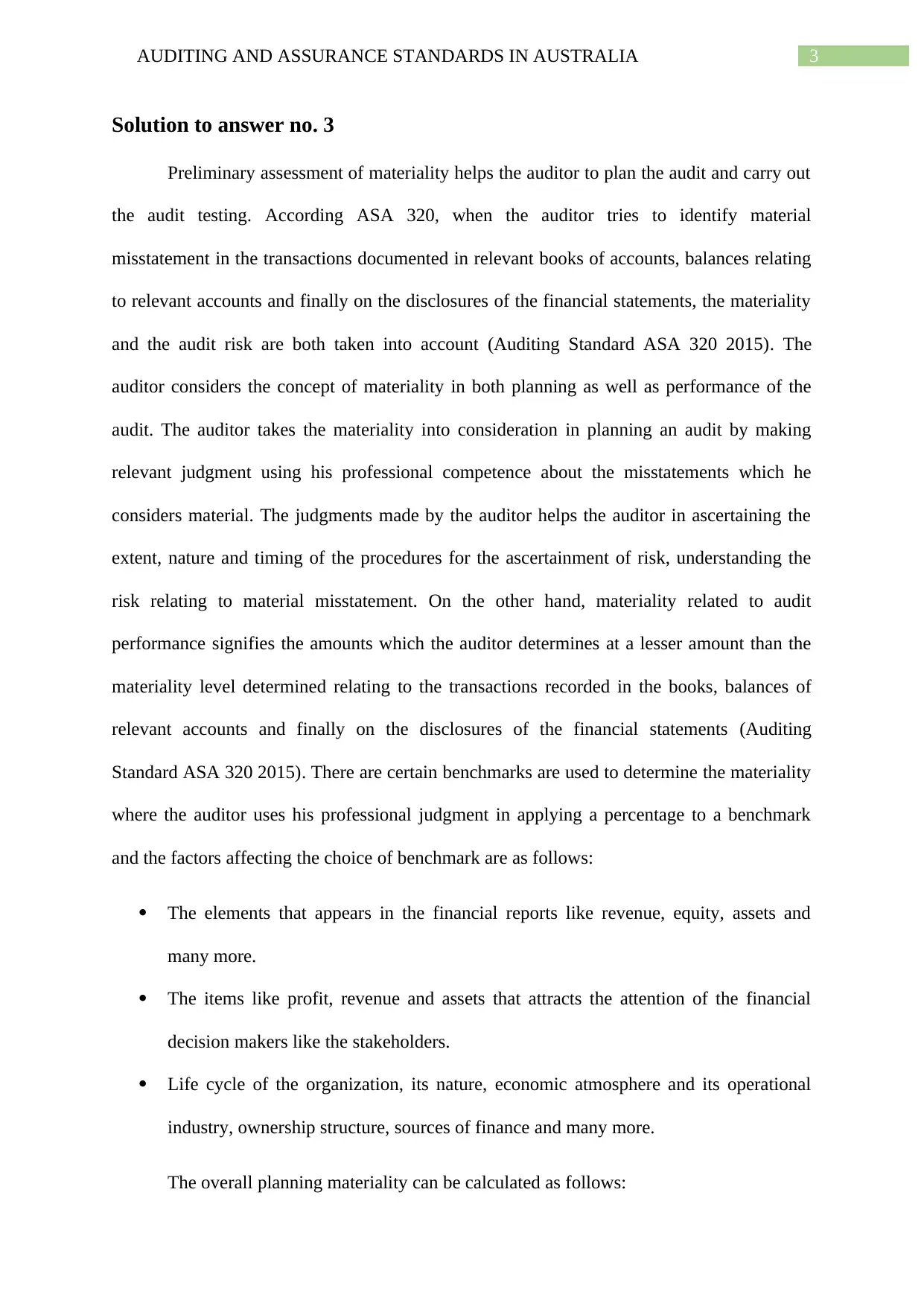
3AUDITING AND ASSURANCE STANDARDS IN AUSTRALIA
Solution to answer no. 3
Preliminary assessment of materiality helps the auditor to plan the audit and carry out
the audit testing. According ASA 320, when the auditor tries to identify material
misstatement in the transactions documented in relevant books of accounts, balances relating
to relevant accounts and finally on the disclosures of the financial statements, the materiality
and the audit risk are both taken into account (Auditing Standard ASA 320 2015). The
auditor considers the concept of materiality in both planning as well as performance of the
audit. The auditor takes the materiality into consideration in planning an audit by making
relevant judgment using his professional competence about the misstatements which he
considers material. The judgments made by the auditor helps the auditor in ascertaining the
extent, nature and timing of the procedures for the ascertainment of risk, understanding the
risk relating to material misstatement. On the other hand, materiality related to audit
performance signifies the amounts which the auditor determines at a lesser amount than the
materiality level determined relating to the transactions recorded in the books, balances of
relevant accounts and finally on the disclosures of the financial statements (Auditing
Standard ASA 320 2015). There are certain benchmarks are used to determine the materiality
where the auditor uses his professional judgment in applying a percentage to a benchmark
and the factors affecting the choice of benchmark are as follows:
The elements that appears in the financial reports like revenue, equity, assets and
many more.
The items like profit, revenue and assets that attracts the attention of the financial
decision makers like the stakeholders.
Life cycle of the organization, its nature, economic atmosphere and its operational
industry, ownership structure, sources of finance and many more.
The overall planning materiality can be calculated as follows:
Solution to answer no. 3
Preliminary assessment of materiality helps the auditor to plan the audit and carry out
the audit testing. According ASA 320, when the auditor tries to identify material
misstatement in the transactions documented in relevant books of accounts, balances relating
to relevant accounts and finally on the disclosures of the financial statements, the materiality
and the audit risk are both taken into account (Auditing Standard ASA 320 2015). The
auditor considers the concept of materiality in both planning as well as performance of the
audit. The auditor takes the materiality into consideration in planning an audit by making
relevant judgment using his professional competence about the misstatements which he
considers material. The judgments made by the auditor helps the auditor in ascertaining the
extent, nature and timing of the procedures for the ascertainment of risk, understanding the
risk relating to material misstatement. On the other hand, materiality related to audit
performance signifies the amounts which the auditor determines at a lesser amount than the
materiality level determined relating to the transactions recorded in the books, balances of
relevant accounts and finally on the disclosures of the financial statements (Auditing
Standard ASA 320 2015). There are certain benchmarks are used to determine the materiality
where the auditor uses his professional judgment in applying a percentage to a benchmark
and the factors affecting the choice of benchmark are as follows:
The elements that appears in the financial reports like revenue, equity, assets and
many more.
The items like profit, revenue and assets that attracts the attention of the financial
decision makers like the stakeholders.
Life cycle of the organization, its nature, economic atmosphere and its operational
industry, ownership structure, sources of finance and many more.
The overall planning materiality can be calculated as follows:
Paraphrase This Document
Need a fresh take? Get an instant paraphrase of this document with our AI Paraphraser
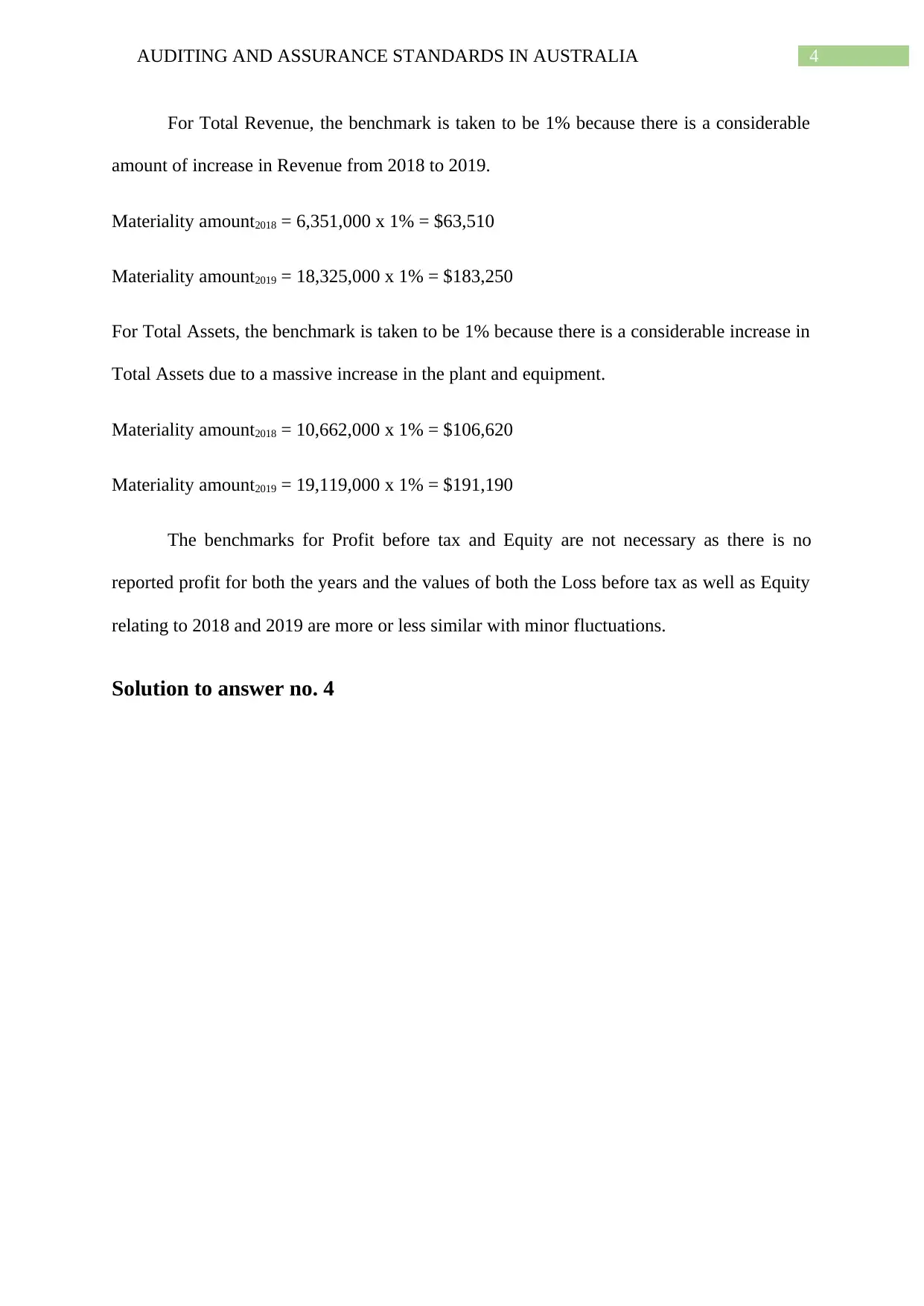
4AUDITING AND ASSURANCE STANDARDS IN AUSTRALIA
For Total Revenue, the benchmark is taken to be 1% because there is a considerable
amount of increase in Revenue from 2018 to 2019.
Materiality amount2018 = 6,351,000 x 1% = $63,510
Materiality amount2019 = 18,325,000 x 1% = $183,250
For Total Assets, the benchmark is taken to be 1% because there is a considerable increase in
Total Assets due to a massive increase in the plant and equipment.
Materiality amount2018 = 10,662,000 x 1% = $106,620
Materiality amount2019 = 19,119,000 x 1% = $191,190
The benchmarks for Profit before tax and Equity are not necessary as there is no
reported profit for both the years and the values of both the Loss before tax as well as Equity
relating to 2018 and 2019 are more or less similar with minor fluctuations.
Solution to answer no. 4
For Total Revenue, the benchmark is taken to be 1% because there is a considerable
amount of increase in Revenue from 2018 to 2019.
Materiality amount2018 = 6,351,000 x 1% = $63,510
Materiality amount2019 = 18,325,000 x 1% = $183,250
For Total Assets, the benchmark is taken to be 1% because there is a considerable increase in
Total Assets due to a massive increase in the plant and equipment.
Materiality amount2018 = 10,662,000 x 1% = $106,620
Materiality amount2019 = 19,119,000 x 1% = $191,190
The benchmarks for Profit before tax and Equity are not necessary as there is no
reported profit for both the years and the values of both the Loss before tax as well as Equity
relating to 2018 and 2019 are more or less similar with minor fluctuations.
Solution to answer no. 4
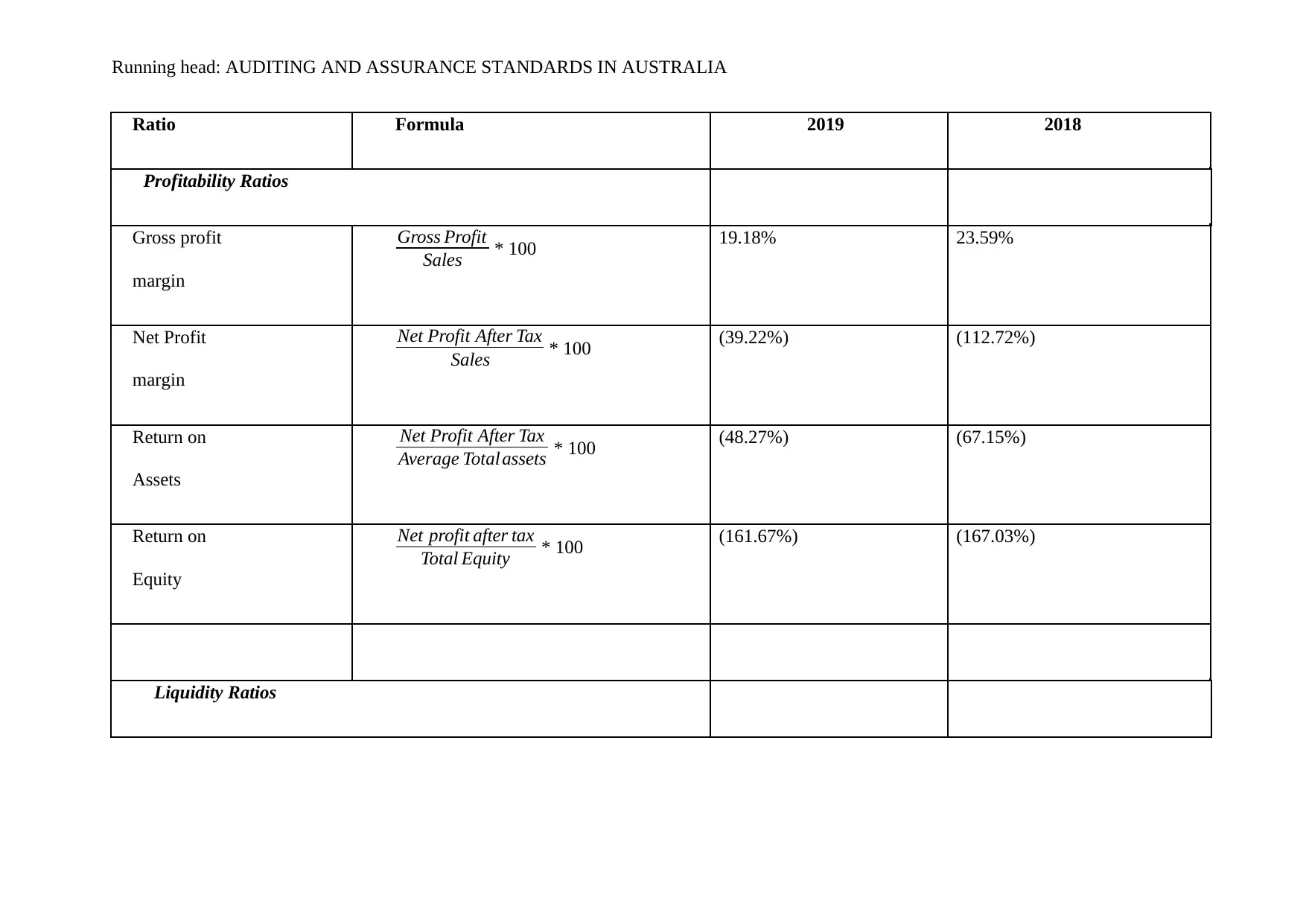
Running head: AUDITING AND ASSURANCE STANDARDS IN AUSTRALIA
Ratio Formula 2019 2018
Profitability Ratios
Gross profit
margin
Gross Profit
Sales * 100 19.18% 23.59%
Net Profit
margin
Net Profit After Tax
Sales * 100 (39.22%) (112.72%)
Return on
Assets
Net Profit After Tax
Average Total assets * 100 (48.27%) (67.15%)
Return on
Equity
Net profit after tax
Total Equity * 100 (161.67%) (167.03%)
Liquidity Ratios
Ratio Formula 2019 2018
Profitability Ratios
Gross profit
margin
Gross Profit
Sales * 100 19.18% 23.59%
Net Profit
margin
Net Profit After Tax
Sales * 100 (39.22%) (112.72%)
Return on
Assets
Net Profit After Tax
Average Total assets * 100 (48.27%) (67.15%)
Return on
Equity
Net profit after tax
Total Equity * 100 (161.67%) (167.03%)
Liquidity Ratios
⊘ This is a preview!⊘
Do you want full access?
Subscribe today to unlock all pages.

Trusted by 1+ million students worldwide
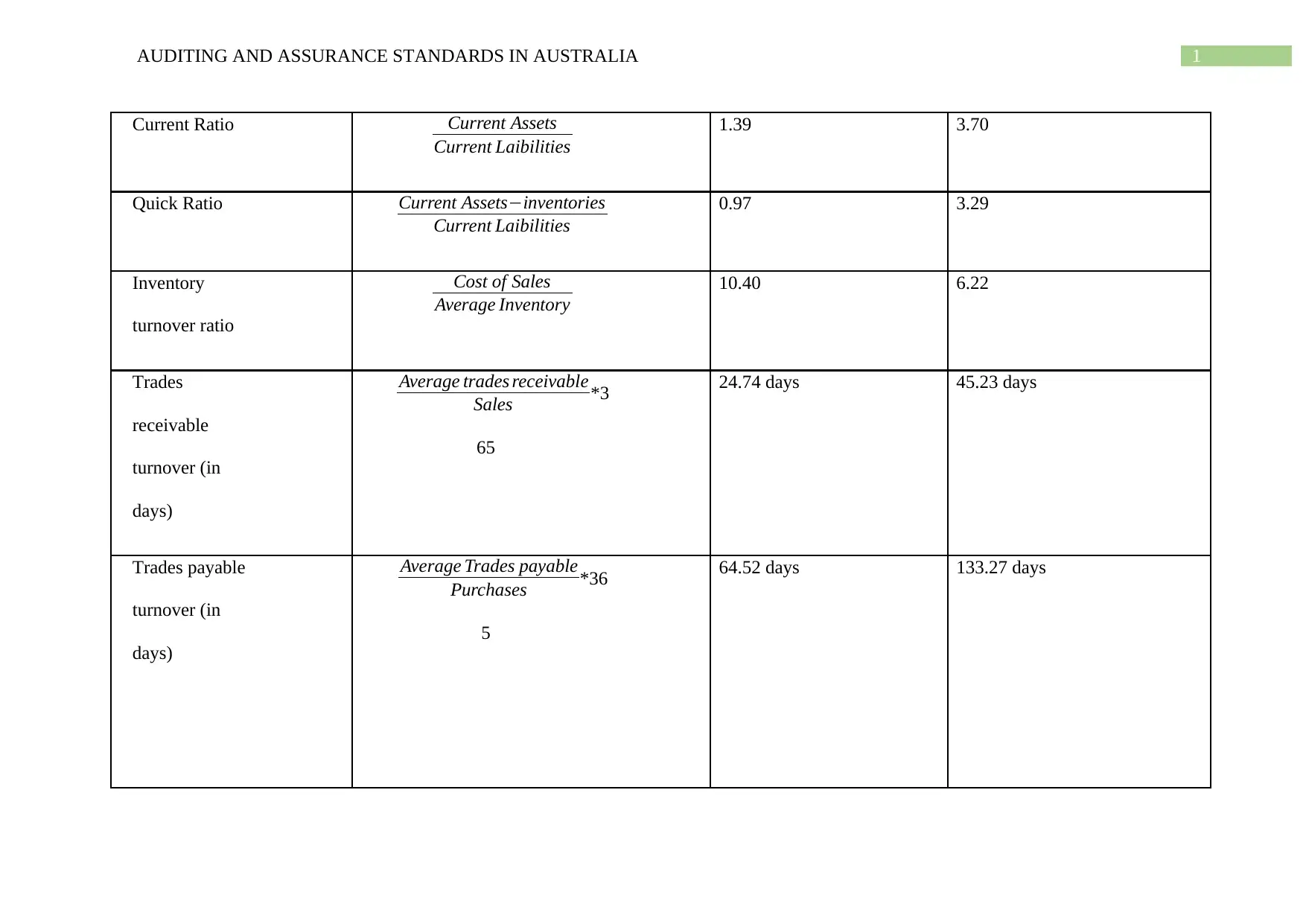
1AUDITING AND ASSURANCE STANDARDS IN AUSTRALIA
Current Ratio Current Assets
Current Laibilities
1.39 3.70
Quick Ratio Current Assets−inventories
Current Laibilities
0.97 3.29
Inventory
turnover ratio
Cost of Sales
Average Inventory
10.40 6.22
Trades
receivable
turnover (in
days)
Average trades receivable
Sales *3
65
24.74 days 45.23 days
Trades payable
turnover (in
days)
Average Trades payable
Purchases *36
5
64.52 days 133.27 days
Current Ratio Current Assets
Current Laibilities
1.39 3.70
Quick Ratio Current Assets−inventories
Current Laibilities
0.97 3.29
Inventory
turnover ratio
Cost of Sales
Average Inventory
10.40 6.22
Trades
receivable
turnover (in
days)
Average trades receivable
Sales *3
65
24.74 days 45.23 days
Trades payable
turnover (in
days)
Average Trades payable
Purchases *36
5
64.52 days 133.27 days
Paraphrase This Document
Need a fresh take? Get an instant paraphrase of this document with our AI Paraphraser
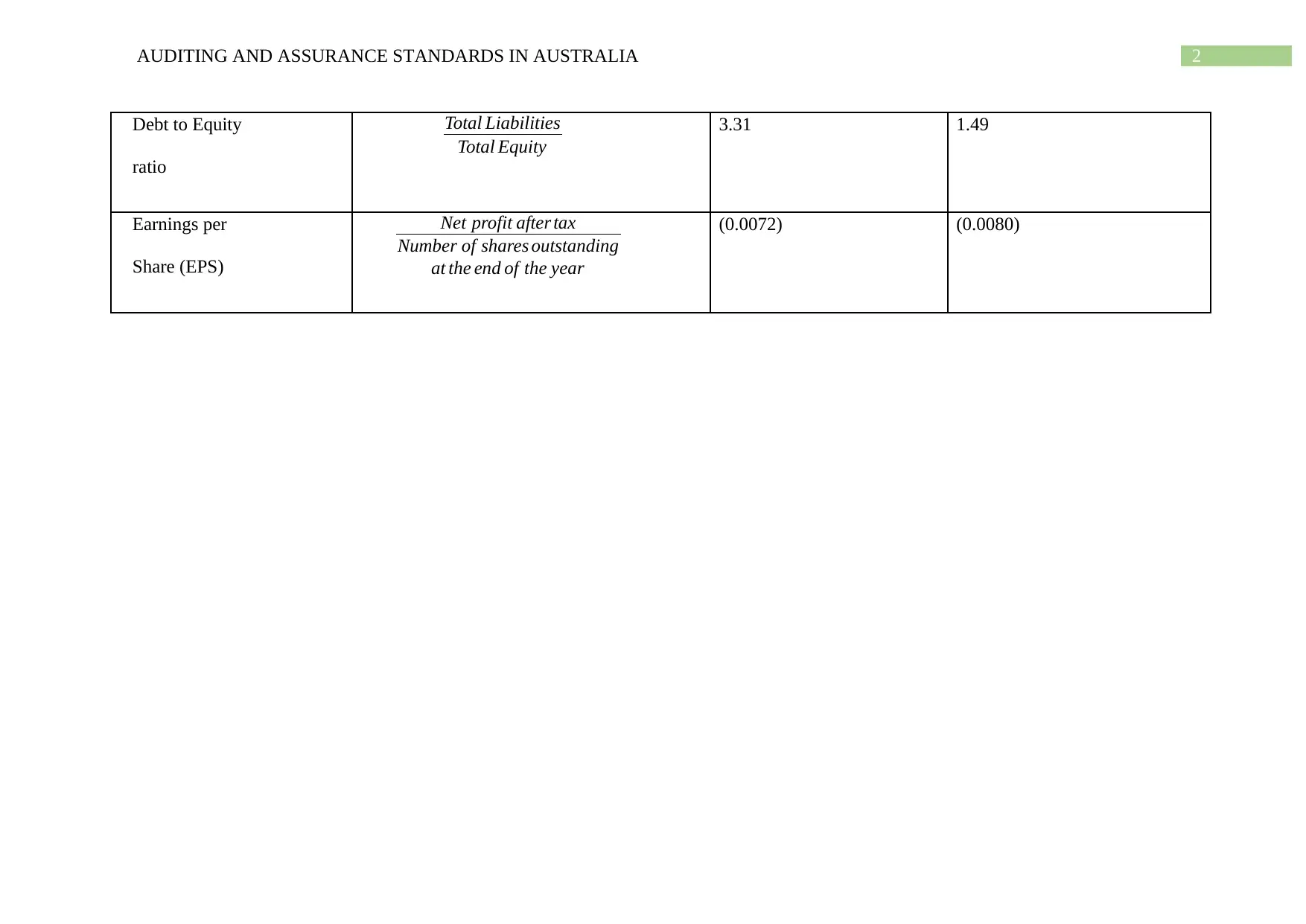
2AUDITING AND ASSURANCE STANDARDS IN AUSTRALIA
Debt to Equity
ratio
Total Liabilities
Total Equity
3.31 1.49
Earnings per
Share (EPS)
Net profit after tax
Number of shares outstanding
at the end of the year
(0.0072) (0.0080)
Debt to Equity
ratio
Total Liabilities
Total Equity
3.31 1.49
Earnings per
Share (EPS)
Net profit after tax
Number of shares outstanding
at the end of the year
(0.0072) (0.0080)
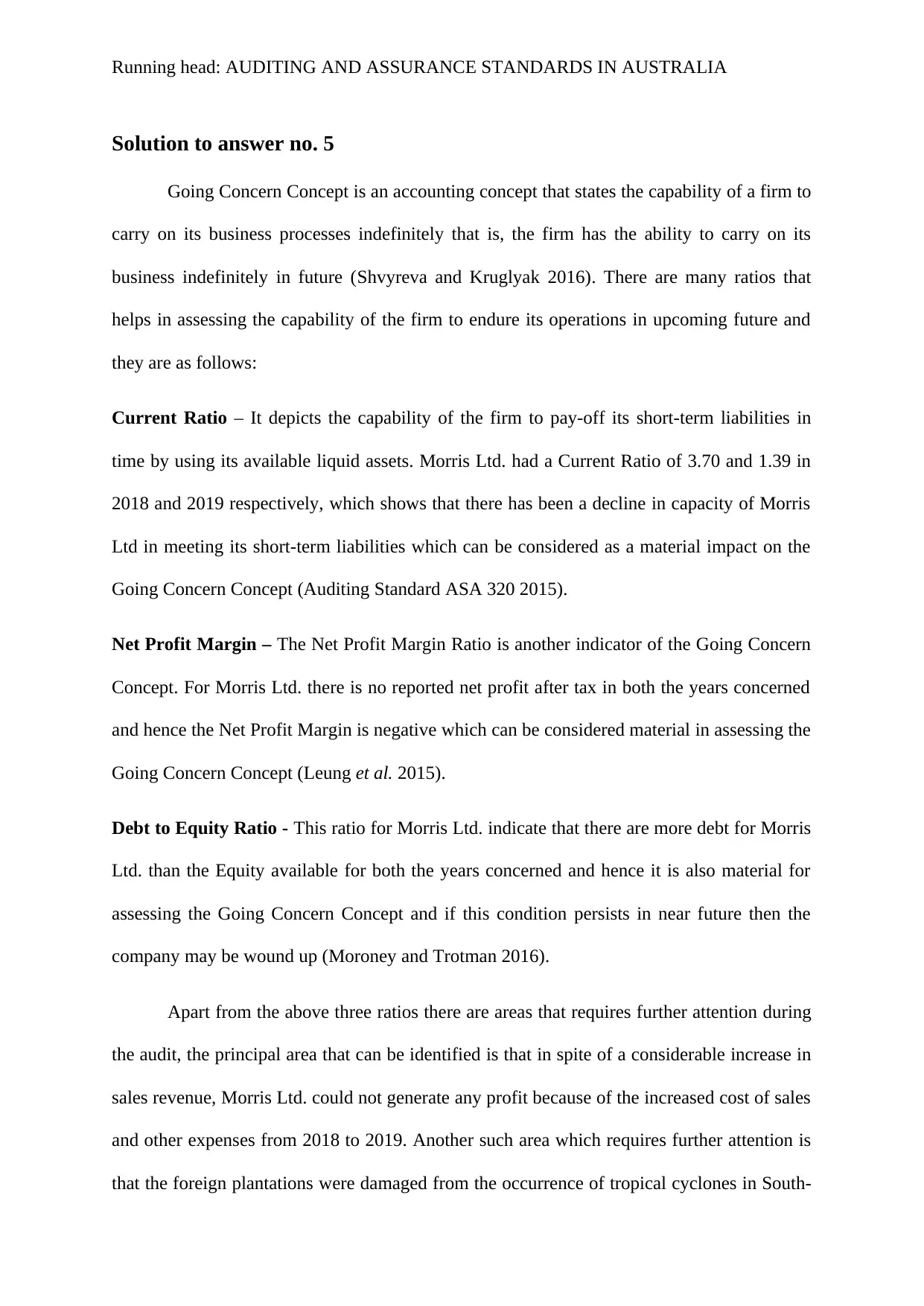
Running head: AUDITING AND ASSURANCE STANDARDS IN AUSTRALIA
Solution to answer no. 5
Going Concern Concept is an accounting concept that states the capability of a firm to
carry on its business processes indefinitely that is, the firm has the ability to carry on its
business indefinitely in future (Shvyreva and Kruglyak 2016). There are many ratios that
helps in assessing the capability of the firm to endure its operations in upcoming future and
they are as follows:
Current Ratio – It depicts the capability of the firm to pay-off its short-term liabilities in
time by using its available liquid assets. Morris Ltd. had a Current Ratio of 3.70 and 1.39 in
2018 and 2019 respectively, which shows that there has been a decline in capacity of Morris
Ltd in meeting its short-term liabilities which can be considered as a material impact on the
Going Concern Concept (Auditing Standard ASA 320 2015).
Net Profit Margin – The Net Profit Margin Ratio is another indicator of the Going Concern
Concept. For Morris Ltd. there is no reported net profit after tax in both the years concerned
and hence the Net Profit Margin is negative which can be considered material in assessing the
Going Concern Concept (Leung et al. 2015).
Debt to Equity Ratio - This ratio for Morris Ltd. indicate that there are more debt for Morris
Ltd. than the Equity available for both the years concerned and hence it is also material for
assessing the Going Concern Concept and if this condition persists in near future then the
company may be wound up (Moroney and Trotman 2016).
Apart from the above three ratios there are areas that requires further attention during
the audit, the principal area that can be identified is that in spite of a considerable increase in
sales revenue, Morris Ltd. could not generate any profit because of the increased cost of sales
and other expenses from 2018 to 2019. Another such area which requires further attention is
that the foreign plantations were damaged from the occurrence of tropical cyclones in South-
Solution to answer no. 5
Going Concern Concept is an accounting concept that states the capability of a firm to
carry on its business processes indefinitely that is, the firm has the ability to carry on its
business indefinitely in future (Shvyreva and Kruglyak 2016). There are many ratios that
helps in assessing the capability of the firm to endure its operations in upcoming future and
they are as follows:
Current Ratio – It depicts the capability of the firm to pay-off its short-term liabilities in
time by using its available liquid assets. Morris Ltd. had a Current Ratio of 3.70 and 1.39 in
2018 and 2019 respectively, which shows that there has been a decline in capacity of Morris
Ltd in meeting its short-term liabilities which can be considered as a material impact on the
Going Concern Concept (Auditing Standard ASA 320 2015).
Net Profit Margin – The Net Profit Margin Ratio is another indicator of the Going Concern
Concept. For Morris Ltd. there is no reported net profit after tax in both the years concerned
and hence the Net Profit Margin is negative which can be considered material in assessing the
Going Concern Concept (Leung et al. 2015).
Debt to Equity Ratio - This ratio for Morris Ltd. indicate that there are more debt for Morris
Ltd. than the Equity available for both the years concerned and hence it is also material for
assessing the Going Concern Concept and if this condition persists in near future then the
company may be wound up (Moroney and Trotman 2016).
Apart from the above three ratios there are areas that requires further attention during
the audit, the principal area that can be identified is that in spite of a considerable increase in
sales revenue, Morris Ltd. could not generate any profit because of the increased cost of sales
and other expenses from 2018 to 2019. Another such area which requires further attention is
that the foreign plantations were damaged from the occurrence of tropical cyclones in South-
⊘ This is a preview!⊘
Do you want full access?
Subscribe today to unlock all pages.

Trusted by 1+ million students worldwide
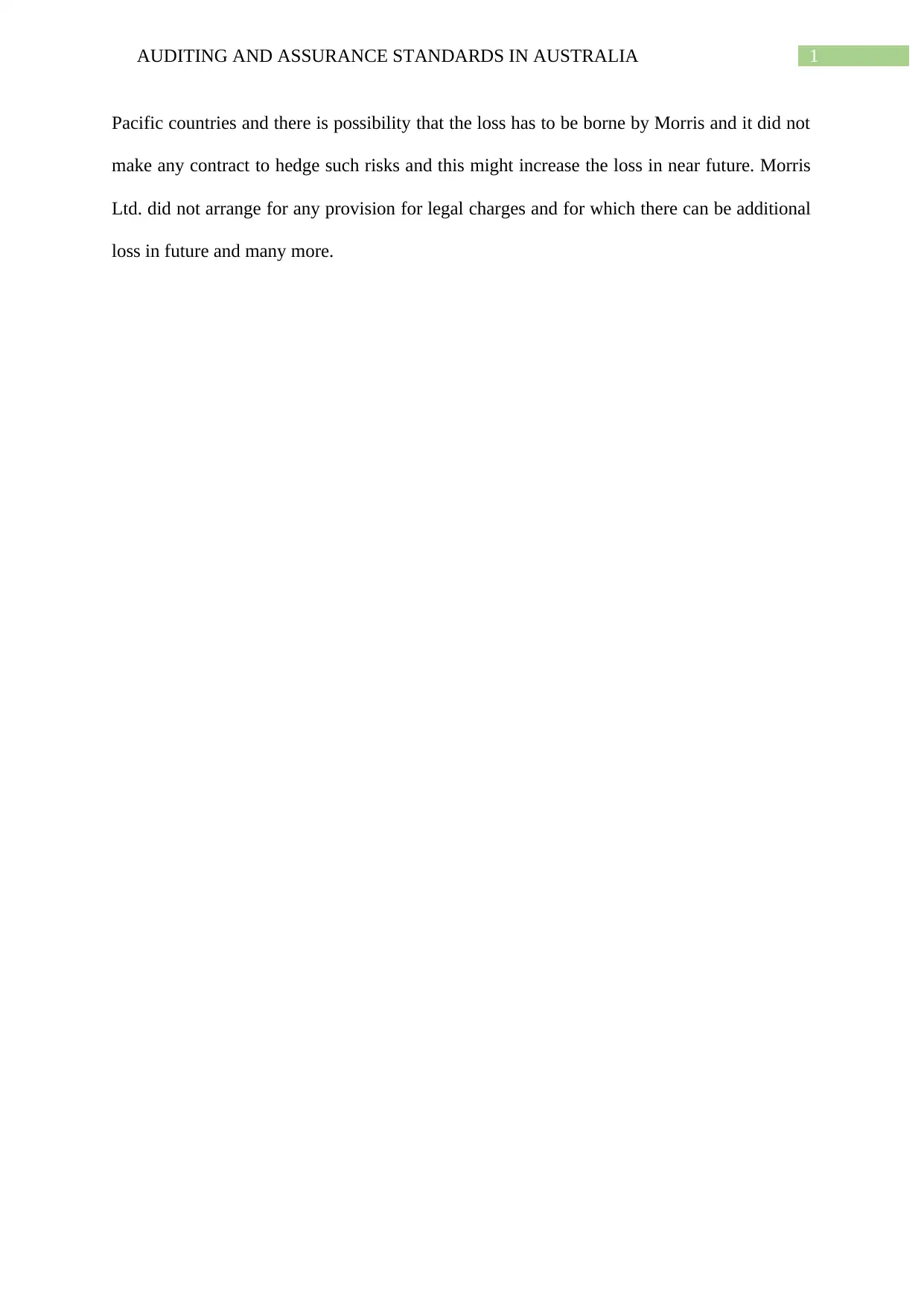
1AUDITING AND ASSURANCE STANDARDS IN AUSTRALIA
Pacific countries and there is possibility that the loss has to be borne by Morris and it did not
make any contract to hedge such risks and this might increase the loss in near future. Morris
Ltd. did not arrange for any provision for legal charges and for which there can be additional
loss in future and many more.
Pacific countries and there is possibility that the loss has to be borne by Morris and it did not
make any contract to hedge such risks and this might increase the loss in near future. Morris
Ltd. did not arrange for any provision for legal charges and for which there can be additional
loss in future and many more.
Paraphrase This Document
Need a fresh take? Get an instant paraphrase of this document with our AI Paraphraser
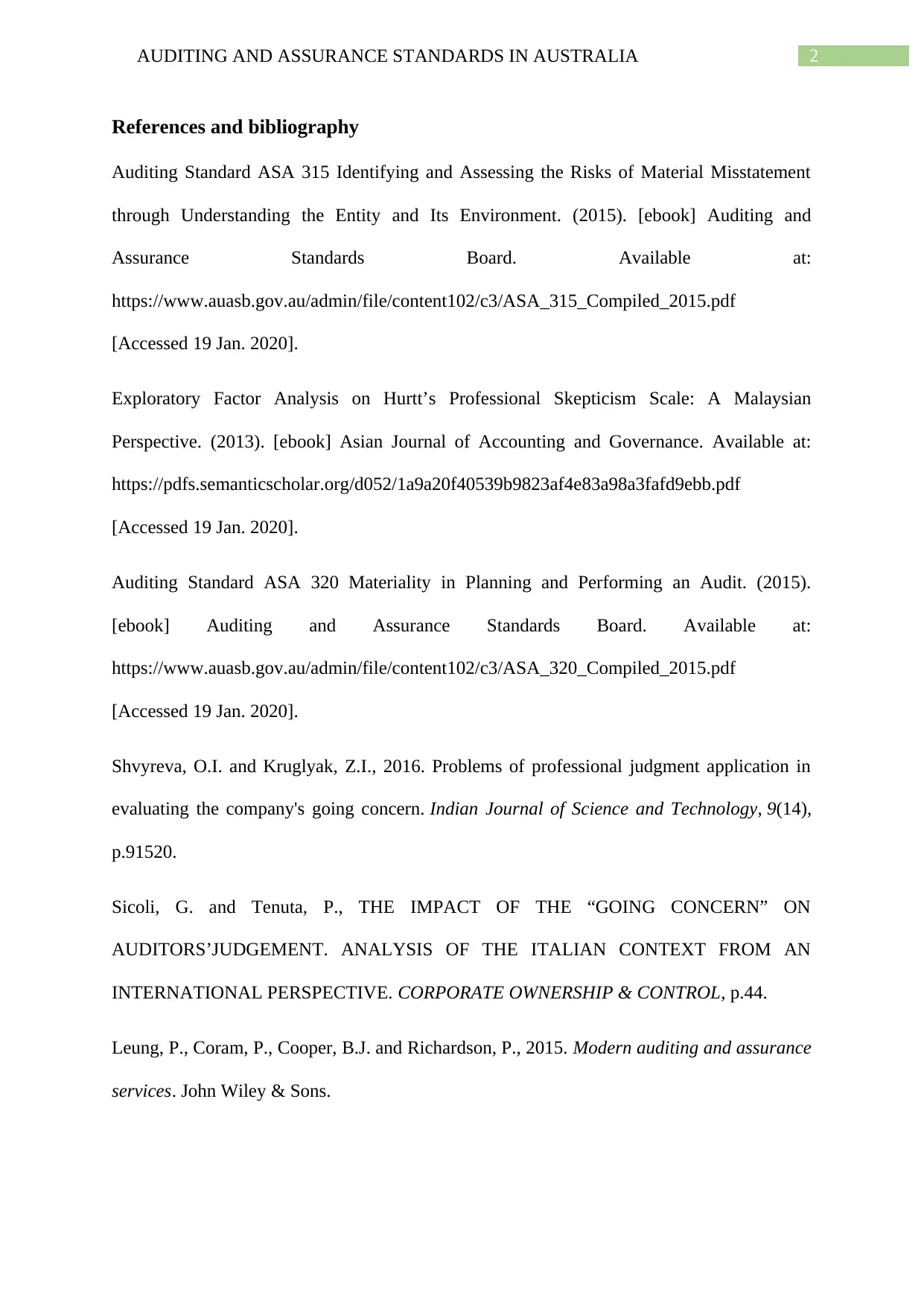
2AUDITING AND ASSURANCE STANDARDS IN AUSTRALIA
References and bibliography
Auditing Standard ASA 315 Identifying and Assessing the Risks of Material Misstatement
through Understanding the Entity and Its Environment. (2015). [ebook] Auditing and
Assurance Standards Board. Available at:
https://www.auasb.gov.au/admin/file/content102/c3/ASA_315_Compiled_2015.pdf
[Accessed 19 Jan. 2020].
Exploratory Factor Analysis on Hurtt’s Professional Skepticism Scale: A Malaysian
Perspective. (2013). [ebook] Asian Journal of Accounting and Governance. Available at:
https://pdfs.semanticscholar.org/d052/1a9a20f40539b9823af4e83a98a3fafd9ebb.pdf
[Accessed 19 Jan. 2020].
Auditing Standard ASA 320 Materiality in Planning and Performing an Audit. (2015).
[ebook] Auditing and Assurance Standards Board. Available at:
https://www.auasb.gov.au/admin/file/content102/c3/ASA_320_Compiled_2015.pdf
[Accessed 19 Jan. 2020].
Shvyreva, O.I. and Kruglyak, Z.I., 2016. Problems of professional judgment application in
evaluating the company's going concern. Indian Journal of Science and Technology, 9(14),
p.91520.
Sicoli, G. and Tenuta, P., THE IMPACT OF THE “GOING CONCERN” ON
AUDITORS’JUDGEMENT. ANALYSIS OF THE ITALIAN CONTEXT FROM AN
INTERNATIONAL PERSPECTIVE. CORPORATE OWNERSHIP & CONTROL, p.44.
Leung, P., Coram, P., Cooper, B.J. and Richardson, P., 2015. Modern auditing and assurance
services. John Wiley & Sons.
References and bibliography
Auditing Standard ASA 315 Identifying and Assessing the Risks of Material Misstatement
through Understanding the Entity and Its Environment. (2015). [ebook] Auditing and
Assurance Standards Board. Available at:
https://www.auasb.gov.au/admin/file/content102/c3/ASA_315_Compiled_2015.pdf
[Accessed 19 Jan. 2020].
Exploratory Factor Analysis on Hurtt’s Professional Skepticism Scale: A Malaysian
Perspective. (2013). [ebook] Asian Journal of Accounting and Governance. Available at:
https://pdfs.semanticscholar.org/d052/1a9a20f40539b9823af4e83a98a3fafd9ebb.pdf
[Accessed 19 Jan. 2020].
Auditing Standard ASA 320 Materiality in Planning and Performing an Audit. (2015).
[ebook] Auditing and Assurance Standards Board. Available at:
https://www.auasb.gov.au/admin/file/content102/c3/ASA_320_Compiled_2015.pdf
[Accessed 19 Jan. 2020].
Shvyreva, O.I. and Kruglyak, Z.I., 2016. Problems of professional judgment application in
evaluating the company's going concern. Indian Journal of Science and Technology, 9(14),
p.91520.
Sicoli, G. and Tenuta, P., THE IMPACT OF THE “GOING CONCERN” ON
AUDITORS’JUDGEMENT. ANALYSIS OF THE ITALIAN CONTEXT FROM AN
INTERNATIONAL PERSPECTIVE. CORPORATE OWNERSHIP & CONTROL, p.44.
Leung, P., Coram, P., Cooper, B.J. and Richardson, P., 2015. Modern auditing and assurance
services. John Wiley & Sons.
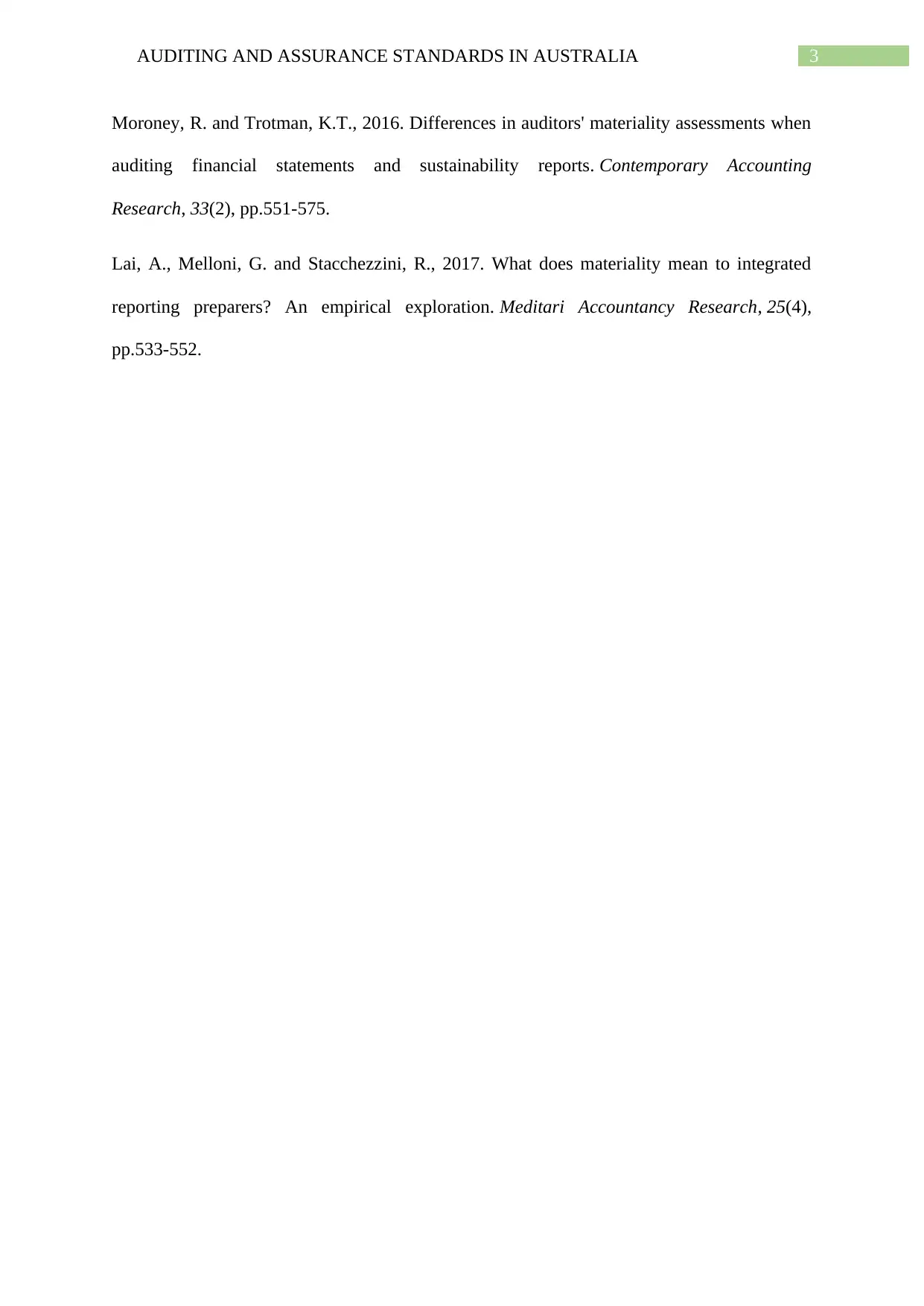
3AUDITING AND ASSURANCE STANDARDS IN AUSTRALIA
Moroney, R. and Trotman, K.T., 2016. Differences in auditors' materiality assessments when
auditing financial statements and sustainability reports. Contemporary Accounting
Research, 33(2), pp.551-575.
Lai, A., Melloni, G. and Stacchezzini, R., 2017. What does materiality mean to integrated
reporting preparers? An empirical exploration. Meditari Accountancy Research, 25(4),
pp.533-552.
Moroney, R. and Trotman, K.T., 2016. Differences in auditors' materiality assessments when
auditing financial statements and sustainability reports. Contemporary Accounting
Research, 33(2), pp.551-575.
Lai, A., Melloni, G. and Stacchezzini, R., 2017. What does materiality mean to integrated
reporting preparers? An empirical exploration. Meditari Accountancy Research, 25(4),
pp.533-552.
⊘ This is a preview!⊘
Do you want full access?
Subscribe today to unlock all pages.

Trusted by 1+ million students worldwide
1 out of 12
Related Documents
Your All-in-One AI-Powered Toolkit for Academic Success.
+13062052269
info@desklib.com
Available 24*7 on WhatsApp / Email
![[object Object]](/_next/static/media/star-bottom.7253800d.svg)
Unlock your academic potential
Copyright © 2020–2025 A2Z Services. All Rights Reserved. Developed and managed by ZUCOL.




